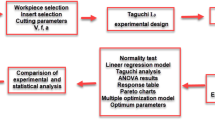Abstract
The great challenge of the modern industry is carrying out an online prediction in the shop floor during the machining to define the exact instant of tool breakage and simultaneously improve the quality of manufactured products. This work shows a study to examine the effect of the feed rate, depth of cut, cooling system, and type of tool on the responses: surface roughness, passive force (Fp), feed rate force (Ff), cutting force (Fc), and micro hardness in the turning of Ti-6Al-4V titanium alloy. Experimental tests were carried out with workpieces 4 mm in diameter, and the surface roughness, micro hardness, and cutting efforts were analyzed. The analysis of variance was used to define the influence of input parameters on the responses. The results showed that the lowest surface roughness was achieved using the carbide tool with code TPMT and the lower input parameters, but the most important parameter was feed rate. The cutting efforts were influenced by feed rate and depth of cut. On the other hand, the cooling system does not show good efficiency in the cutting efforts. However, the geometry of the tool and the Minimum Quantity Lubrication system were more effective to cause the hardening in micro scale at the surface of the material.
Similar content being viewed by others
References
Abouelatta O, Madl J (2001) Surface roughness prediction based on cutting parameters and tool vibration in turning. J Mater Process Technol 118:269–277
Brandão LC, Coelho RT, Rodrigues AR (2008) Experimental and theoretical study of workpiece temperature when end milling hardened steels using (TiAl)N-coated and PcBN-tipped tools. Journal of materials processing Technology 199:234–244
Cedergren S, Petti G, Sjöberg G (2013) On the influence of work material microstructure on chip formation, cutting forces and acoustic emission when machining Ti-6Al-4V. Procedia CIRP 12:55–60
Chiappini E, Tirelli S, Albertelli P, Strano M, Monno M (2014) On the mechanics of chip formation in Ti–6Al–4V turning with spindle speed variation. International Journal of Machine Tools & Manufacture 77:16–26
Deiab I, Raza SW, Pervaiz S (2014) Analysis of lubrication strategies for sustainable machining during turning of titanium Ti-6Al-4V alloy. Procedia CIRP 17:766–771
Ezugwu EO, Bonney J, da Silva RB, Çakir O (2007) Surface integrity of finished turned Ti–6Al–4V alloy with PCD tools using conventional and high pressure coolant supplies. Int J Machine Tools Manufacture 47:884–891
Maciel DT, Ribeiro Filho SLM, Lauro CH, Brandão LC (2015) Characteristics of machined and formed external threads in titanium alloy. International Journal Advanced Manufacturing Technology 7:779–792
Montgomery DC (2005) Design and analysis of experiments, 6a edn. Arizona John Wiley & Sons Inc.
Pramanik A (2012) Problems and solutions in machining of titanium alloys. International Journal Advanced manufacturing Technology 70/5:919–928
Revankar GD, Shetty R, Rao SS, Gaitonde VN (2014) Analysis of surface roughness and hardness in titanium alloy machining with polycrystalline diamond tool under different lubricating modes. Mater Res 2014(17/4):1010–1022
Ribeiro Filho SLM, Lauro CH, Bueno AHS, Brandão LC, (2016a- A) Influence cutting parameters on the surface quality and corrosion behavior of Ti–6Al–4V alloy in synthetic body environment (SBF) using response surface method Measurement 8, 223–237.
Ribeiro Filho SLM, Lauro CH, Bueno AHS, Brandão LC, (2016b- B) Effects of the dynamic tapping process on the biocompatibility of Ti-6Al-4V alloy in simulated human body environment Arabian Journal for science and Engineering 41 4313–4326
Rotella G, Dillon OW Jr, Umbrello D, Settineri L, Jawahir IS (2014) The effects of cooling conditions on surface integrity in machining of Ti6Al4V alloy. International Journal Advanced Manufacturing Technology 71:47–55
Salgado DR, Alonso FJ, Cambero I, Marcelo A (2009) In-process surface roughness prediction system using cutting vibrations in turning. International Journal of Advanced Manufacturing Technology 43:40–51
Sandvik Coromant turning tools manual (2012)
Singaravel B, Selvaraj T (2015) A review of micro hardness measurement in turning operation. Applied Mechanics and Materials 813–814:274–278
Wang Q, Liu Z, Wang B, Song Q, Wan Y, (2015) Evolutions of grain size and micro-hardness during chip formation and machined surface generation for Ti-6Al-4V in high-speed machining International Journal Advanced Manufacturing Technology 82/9 1725–1736
Wu JCF, Hamada MS, (2009) Experiments—planning, analysis, and optimization, 2nd ed, Wiley series in probability and statistics USA 700
Zhou JM, Anderson M, Stahl JE (2003) The monitoring of flank wear on the CBN tool in the hard turning process. International Journal of Advanced Manufacturing Technology 22:697–702
Author information
Authors and Affiliations
Corresponding author
Rights and permissions
About this article
Cite this article
de Oliveira, J.A., Ribeiro Filho, S.L.M., Lauro, C.H. et al. Analysis of the micro turning process in the Ti-6Al-4V titanium alloy. Int J Adv Manuf Technol 92, 4009–4016 (2017). https://doi.org/10.1007/s00170-017-0449-0
Received:
Accepted:
Published:
Issue Date:
DOI: https://doi.org/10.1007/s00170-017-0449-0




